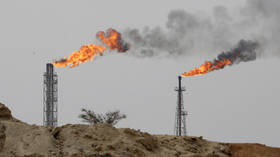Global outages boost oil prices

Oil prices are on track for strong gains this week, and the price increases are not only the result of the crisis in Venezuela.
The oil market received a boost from the US Federal Reserve this week, which signaled on Wednesday that it would essentially suspend its plans to hike interest rates this year. Fed chairman Jerome Powell said that economic growth remained “solid” but that the central bank had “the luxury of patience” when deciding on further rate hikes. That is a big change from prior guidance, in which the Fed very clearly outlined multiple rate increases in 2019.
“The case for raising rates has weakened somewhat,” Powell said. Slowing growth in China and Europe, a weakening housing market, tepid inflation – these are not exactly the ingredients that call for aggressive rate tightening.
The announcement contributed to strong gains for oil prices on Wednesday and Thursday. At the time of this writing, WTI was trading in the mid-$50s, with Brent above $62 per barrel, both close to two-month highs.
READ MORE: Russia vows to defend its Venezuelan oil assets
A more dovish position from the Fed boosts the bullish case for oil in two ways. First, lower-than-expected interest rates will provide a jolt to the economy. Stock markets rose on the news. But second, a softer rate outlook also undercuts the US dollar a bit. A weaker dollar stokes crude oil demand in the rest of the world, and historically the dollar has had an inverse relationship with oil prices.
Meanwhile, the oil market received a more direct boost this week on news that Saudi Arabia slashed shipments to the United States. The US has the most transparent and up-to-date data on the oil market, which include weekly releases on production levels, imports and exports, and inventories. That kind of visibility is not readily available in most places around the world.
As a result, Saudi Arabia appears to be deliberately targeting that data. By reducing shipments to the US specifically, Riyadh can help create the appearance of a tightening oil market. Saudi shipments to the US dropped by 528,000 bpd last week to just 442,000 bpd, the lowest weekly total in more than two years.
Also on rt.com Oil markets could see deficit in 2019More to the point, OPEC’s production declined by 890,000 bpd in January, according to a Reuters survey, the largest monthly decline since early 2017 (the month that the first round of OPEC+ production cuts took effect). Iraq produced above its production ceiling, but aside from that, the cartel is well on its way to implementing the production curbs.
In fact, there is suddenly a remarkable confluence of events pushing oil in a bullish direction. First and foremost are the OPEC+ production cuts of 1.2 mb/d that are phasing in. But beyond that, US shale is starting to slowdown, and while output is still expected to grow this year, the increase could be the smallest in years.
Then there are the supply outages. Libya lost some output unexpectedly in December, with some of its production still offline. Iran sanctions waivers are set to expire in May, and the US hopes to further cut into Iranian oil exports. The new sanctions on Venezuela threaten to create yet another major source of supply outages.
In fact, when considering that OPEC+ is determined to keep 1.2 mb/d of supply off of the market, and painful US sanctions on Venezuela and Iran threaten to shut in even more output, it’s pretty amazing that Brent crude is only trading at $62 per barrel. The Fed backing off interest rate hikes is the cherry on top.
Traders and investors are starting to wake up to this bullish sentiment. “The market is more convinced that there will be aggressive production cuts and the macro picture has improved a bit. That’s positive for prices going forward,” Jean-Louis Le Mee, CEO of London-based oil hedge fund Westbeck Capital, told the Wall Street Journal.
Another investor echoed that sentiment in comments to the WSJ. “The Saudis are sincere about higher oil prices, they need to balance their budget. The OPEC cuts will lower stocks so I’m pretty bullish,” said Mark Gordon, portfolio manager at the Ascent Oil Fund.
Oil prices are back up to where they were in November, and significant outages from Venezuela in the short run could pave the way for more price increases.
This article was originally published on Oilprice.com















